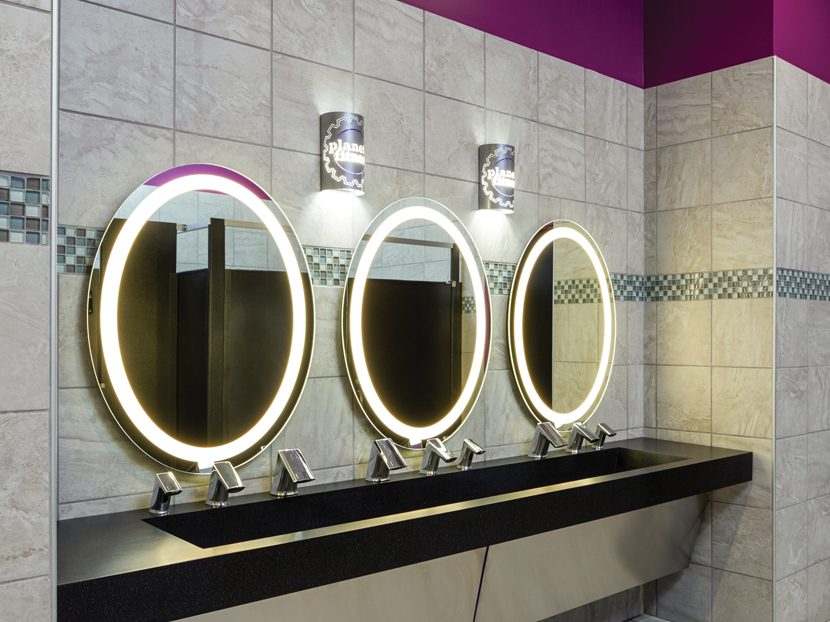A Hands-Off Approach to Hygiene
Facilities are now replacing manual fixtures in favor of automatic, sensor-operated products to create a more hygienic restroom environment.

We’re all taught the same hygienic practice at a young age — to wash our hands after using the restroom.
That has never been stressed more than it is right now, as the COVID-19 pandemic has brought the importance of hand hygiene front and center to combat the ill-effects of the virus.
But what if by using manual faucets, soap dispensers and hand dryers, you are exposing yourself to the very thing you’re hoping to avoid by washing your hands in the first place?
Considering that public restrooms can see up to thousands of users each day, high-touch surfaces such as faucet and flushometer handles can be breeding grounds for cross-contamination. But this high-traffic volume also presents an excellent opportunity for facilities of all types to take a significant step toward limiting the spread of germs, bacteria and viral infections.
That’s why touch-free restroom products are being specified now more than ever before. Facilities are now replacing manual fixtures in favor of automatic, sensor-operated products to create a more hygienic restroom environment.
From Faucets to Flushometers
While all facilities can benefit from touch-free technology, there are specific considerations that different types of environments need to take into account. For example, high-frequency use buildings — public transit facilities, casinos, etc. — are best suited for low- to mid-height automatic faucets to guard against splashing and slip-and-fall liability.
Commercial restroom manufacturers are now developing integrated sink systems where the faucet, soap dispenser and hand dryer all work together in an integrated and touch-free unit to promote proper hygiene while also eliminating unnecessary dripping on the floor typically associated with sinks being several feet away from the hand dryer.
Planet Fitness in Palmdale, Calif., specified Sloan’s AER-DEC integrated sink system for this exact reason, ensuring they present a clean and welcoming experience for guests. Not only does the integrated sink system eliminate excess water on the countertops and floors, but it does so in a safe and sanitary way without the use of paper towels.
Touch-free faucets can be specified through either infrared sensor technology or capacitance (proximity) technology. Infrared sensors pick up the reflection of infrared light when a valid “target” is within range. Proximity sensors sense the electrical field surrounding a valid target when within the range but cannot be used on metal sinks. In both instances, the range can be adjusted.
LCD screens also are utilized for several user benefits. Some faucets walk users through a CDC-compliant handwashing process. In other instances, visible diagnostics can communicate the “health” of batteries and other items to take the guesswork out of repairs for facilities teams.
But touch-free technology also pertains to flushometers, another high-touch surface area that technology is now able to eliminate. Retrofit kits are helping convert manual flushometers to touch-free operation in just a few minutes.
Top-mount sensor flushometers simply replace the cover and diaphragm assembly — requiring a quick shut-off of the water supply — and allow for the flush volume to be changed over time. Side-mount flushometers either replace or fit over the handle assembly — without having to shut off the water — but the fixtures flush volume will remain constant over time.
Both retrofits can be installed in under seven minutes. If the sensor is unable to operate and the batteries are depleted, true mechanical override technology allows for a manual flush.
The Battle Against Bacteria
While touch-free operations help to guard against the spread of germs, users still want the peace of mind to know the fixtures they’re using — automatic or manual — are as clean as possible. That’s why manufacturers have developed a glaze to impart hydrophobic (water-repellant) and oleophobic (oil-repellent) properties to vitreous china. These glazes repel liquid and inhibit the growth of germs and bacteria to help maintenance teams by making the fixture easier to clean and keeping it cleaner longer.
When Notre Dame University recently conducted its Campus Crossroads Project, it specified the hydrophobic glaze on all its commercial restroom fixtures. The project is the largest building initiative in school history designed to place Notre Dame Stadium at the intersection of research, student life, event and hospitality space. This helped to keep the products cleaner for a longer period while also eliminating rust stains that had previously been a challenge.
While the movement toward touch-free technology had already begun long before the start of the COVID-19 pandemic, current events have only amplified the need for these products.
Commercial buildings are already implementing health-focused solutions for post-COVID-19 business environments, and the restroom is a significant element. The city of Fayetteville, N.C., is in the process of installing hands-free faucets and self-flushing toilets and urinals at all city facilities.
Fulton East, a 90,000-square-foot office in Chicago, implemented a comprehensive range of health-conscious specifications — from a hands-free elevator system (Toe-To-Go) and airPHX to help reduce cross-contaminant risks and provide employees with cleaner air and work surfaces, to touch-free restroom products.
Currently leasing for a summer opening, Fulton East specified touch-free solar-powered faucets, soap dispensers and flushometers paired with hydrophobic-glazed vitreous china. The facility even constructed all restrooms with one additional fixture than required by Chicago city code to enhance social distancing.
At Sloan, we’re proud to help facilities of all types adapt to the new normal that has come along with COVID-19. We’ve have provided our touch-free products to temporary field hospitals at Chicago’s McCormick Place Convention Center and Yale University to offer sanitary restrooms solutions for those in need.




